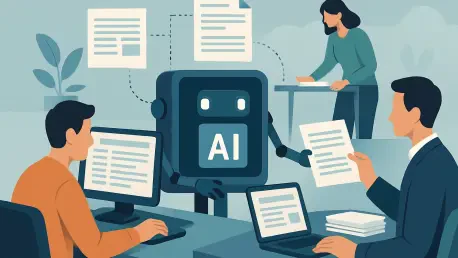In an era where businesses are inundated with vast amounts of unstructured data, Amazon Web Services (AWS) has emerged with a game-changing solution that redefines multi-page document processing, offering a lifeline to industries like finance, healthcare, and legal services. This innovative approach, blending artificial intelligence (AI) with human oversight, tackles the challenge of extracting meaningful insights from complex documents—such as contracts, medical records, and financial reports—often riddled with inconsistencies or unique formats, which have long plagued organizations striving for efficiency. AWS steps in with a hybrid model that automates tedious tasks while ensuring precision through strategic human intervention, promising not just speed but also reliability. By leveraging cutting-edge tools and scalable workflows, this system addresses a critical pain point, transforming how enterprises manage information overload. This exploration delves into the intricacies of the technology, its practical applications, and the future it heralds for document-heavy sectors.
Understanding the Hybrid Model
Core Components and Functionality
The backbone of AWS’s groundbreaking system lies in its seamless integration of AI-driven automation with human-in-the-loop (HITL) verification, ensuring unparalleled accuracy in document processing. Central to this are Amazon Bedrock, which powers generative AI analysis with foundation models like Claude or Titan, and Amazon SageMaker, which facilitates model training and inference. Documents uploaded to Amazon S3 cloud storage undergo meticulous parsing, with AI identifying key entities and structures across multiple pages. What sets this apart is the system’s ability to detect uncertainty—be it from handwritten notes or irregular layouts—and flag such cases for human review via SageMaker Ground Truth. This hybrid approach ensures that while automation handles the bulk of the workload, human expertise refines the output, achieving precision where standalone AI might stumble. Such a balance is vital for industries requiring near-perfect results in data extraction.
Scalability forms another pillar of this model, orchestrated by AWS Step Functions to manage multi-stage workflows capable of processing thousands of documents simultaneously. Complementing Bedrock’s contextual analysis is Amazon Textract, which excels in optical character recognition (OCR), converting scanned text into usable data with remarkable efficiency. Active learning within SageMaker further optimizes the process by limiting human intervention to only 10-20% of cases, focusing on the most ambiguous results. This synergy not only accelerates operations but also maintains high standards of accuracy, making it a robust solution for enterprise needs. Additionally, compliance with stringent regulations like HIPAA and GDPR is embedded through features such as data anonymization and audit trails, ensuring sensitive information remains protected. This thoughtful design underscores AWS’s commitment to balancing technological prowess with practical, secure implementation across diverse sectors.
Workflow and Scalability
The workflow of AWS’s hybrid system is engineered for efficiency, starting from the moment documents are uploaded to Amazon S3 and extending through a meticulously coordinated pipeline. AWS Step Functions play a pivotal role, acting as the conductor of complex, multi-stage processes that handle vast document volumes without bottlenecks. This orchestration ensures that tasks like data extraction, entity recognition, and content structuring occur in parallel, slashing processing times for businesses dealing with high document throughput. Each step is optimized to leverage AI’s speed, with Bedrock models dissecting content across pages to maintain context—a critical feature for lengthy or fragmented files. This systematic approach allows enterprises to scale operations effortlessly, meeting demands without compromising on performance or reliability, even under intense workloads.
Beyond raw scalability, the integration of supplementary tools enhances the system’s adaptability to varied document types and challenges. Amazon Textract, for instance, bolsters the pipeline by providing precise OCR capabilities, turning scanned or image-based files into structured data that AI can analyze further. Meanwhile, the Converse API facilitates interaction with external tools for specialized tasks like table extraction or entity resolution, particularly useful in sectors like healthcare. Human oversight remains strategically minimal, activated only when AI confidence dips, ensuring that resources are allocated efficiently. This balance of automation and manual input, paired with robust compliance mechanisms, positions AWS’s solution as a versatile powerhouse, ready to tackle the nuances of modern document processing while adhering to regulatory demands and operational goals.
Practical Implementation for Developers
Tools and Resources
For developers tasked with harnessing AWS’s hybrid model, a wealth of resources simplifies the journey from concept to deployment, ensuring accessibility even for those new to AI integration. AWS provides starter code through GitHub repositories, offering a practical foundation for building document processing pipelines. Detailed guides on the AWS Machine Learning Blog further demystify the setup, walking through each stage from uploading files to triggering automated workflows. AWS Lambda functions stand out as a key enabler, allowing developers to initiate processing automatically upon file upload, streamlining operations without manual intervention. These tools collectively lower the entry barrier, empowering teams to experiment and implement solutions tailored to specific business challenges, whether in small-scale pilots or expansive enterprise systems, with minimal friction.
Beyond foundational support, AWS ensures developers have the flexibility to refine and optimize their implementations through comprehensive documentation and community insights. The Machine Learning Blog not only covers technical setups but also shares best practices for integrating services like Bedrock and SageMaker into existing workflows. This guidance is invaluable for crafting efficient systems that align with organizational goals, such as reducing processing times or enhancing data accuracy. Additionally, the availability of forums and social media discussions amplifies learning, as developers exchange real-world experiences and solutions. By providing these robust resources, AWS fosters an environment where innovation thrives, enabling the creation of intelligent systems that adapt to evolving needs while maintaining a focus on precision and scalability across diverse document processing scenarios.
Customization Options
Customization lies at the heart of AWS’s appeal to developers, offering the ability to tailor the hybrid model to unique industry requirements with remarkable ease. Through SageMaker, fine-tuning AI models with domain-specific datasets becomes a straightforward process, allowing the system to grasp specialized jargon or unconventional document formats prevalent in sectors like legal or medical fields. This adaptability ensures that the AI isn’t just a generic tool but a precision instrument honed for particular challenges, such as interpreting complex financial statements or patient records. Developers can iterate on these customizations, testing and refining outputs to achieve optimal performance, thereby bridging the gap between generic automation and niche operational needs with finesse.
Further enhancing this flexibility is the integration of open-weight models like Meta’s Llama on platforms such as Bedrock and SageMaker, expanding the reasoning capabilities of the system. Developers gain access to a broader toolkit, enabling them to select or combine models that best suit their project’s demands, whether for deeper contextual analysis or improved entity recognition. Tools like LangChain can also be incorporated to chain AI actions, adding layers of functionality such as automated note generation from multimodal data. This level of customization not only boosts the system’s relevance across varied applications but also empowers developers to push creative boundaries, crafting solutions that evolve with industry trends and technological advancements while maintaining a sharp focus on accuracy and efficiency.
Real-World Impact and Future Potential
Industry Applications
The transformative power of AWS’s hybrid model becomes strikingly evident in real-world applications, particularly within document-heavy industries like finance and healthcare. In finance, processing multi-page loan applications—a task traditionally bogged down by manual effort—becomes remarkably efficient as AI extracts routine data points such as income details or credit scores, while human reviewers verify critical or ambiguous entries. This synergy slashes turnaround times, enabling faster decision-making without sacrificing accuracy, a boon for banks and lending institutions under constant pressure to streamline operations. The system’s ability to handle high volumes while maintaining precision offers a competitive edge, redefining how financial entities manage their core workflows amidst growing digital demands.
In healthcare, the hybrid approach proves equally impactful by addressing the dual challenges of accuracy and privacy in managing medical records. AI components swiftly parse extensive patient histories or billing forms, identifying key entities like diagnoses or treatment codes, while human oversight ensures no critical detail is misread, especially in handwritten notes. Compliance with regulations like HIPAA is seamlessly integrated through data anonymization before review, safeguarding sensitive information. This balance not only accelerates administrative tasks but also builds trust in automated systems handling personal data. From Medicaid forms to clinical reports, the technology demonstrates versatility, proving its worth as a reliable ally in sectors where errors carry significant consequences, paving the way for broader adoption.
Future Innovations
Looking to the horizon, AWS shows unwavering commitment to advancing its hybrid model with continuous enhancements to Bedrock and SageMaker, signaling a future of even greater precision in document processing. Recent integrations of new embeddings and models like Meta’s Llama hint at improved contextual understanding across complex, multi-page files, a development that could further reduce the need for human intervention. Industry discussions on social platforms reflect palpable excitement about these updates, with experts anticipating general availability of features that refine entity resolution and table extraction. Such innovations promise to elevate the system’s capabilities, making it an indispensable tool for businesses navigating the intricacies of unstructured data in an increasingly digital landscape.
Enthusiasm for AWS’s direction is matched by the potential for broader applications, as ongoing advancements open doors to novel use cases beyond current industry norms. The focus on multimodal data processing, for instance, suggests future systems might effortlessly handle a mix of text, images, and audio within documents, expanding utility in areas like education or media. Developers are encouraged to explore these evolving tools through proof-of-concept projects, starting small to grasp emerging functionalities before scaling. As AWS pushes boundaries, the hybrid model stands poised to redefine efficiency standards, offering solutions that not only address today’s challenges but also anticipate tomorrow’s needs. This forward-thinking approach cements AWS’s role as a trailblazer in reshaping how enterprises conquer document management hurdles.









